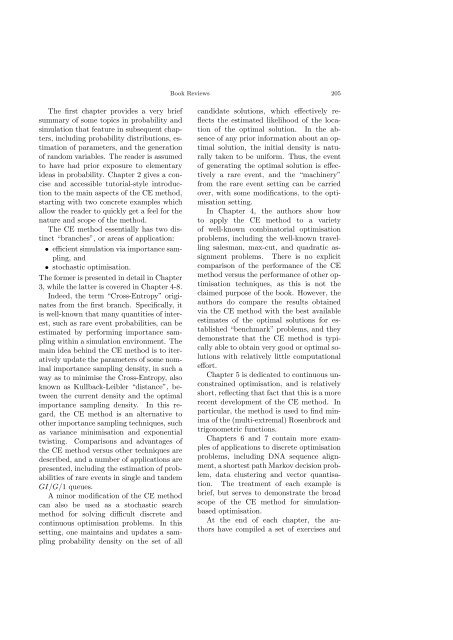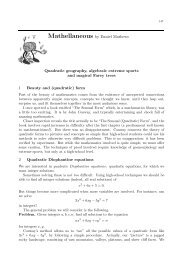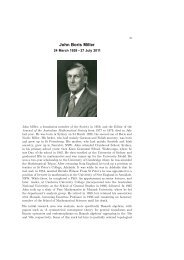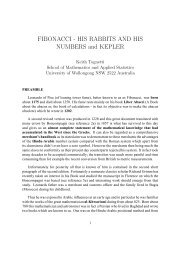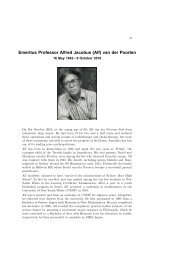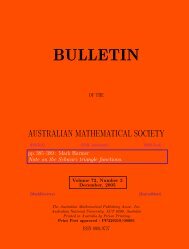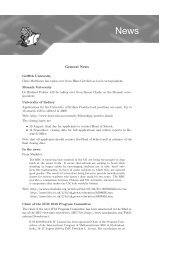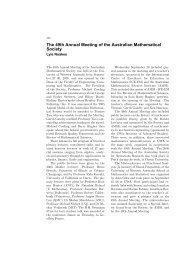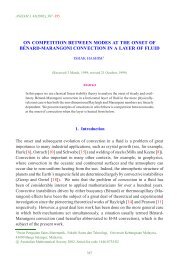Gazette 31 Vol 3 - Australian Mathematical Society
Gazette 31 Vol 3 - Australian Mathematical Society
Gazette 31 Vol 3 - Australian Mathematical Society
Create successful ePaper yourself
Turn your PDF publications into a flip-book with our unique Google optimized e-Paper software.
The first chapter provides a very brief<br />
summary of some topics in probability and<br />
simulation that feature in subsequent chapters,<br />
including probability distributions, estimation<br />
of parameters, and the generation<br />
of random variables. The reader is assumed<br />
to have had prior exposure to elementary<br />
ideas in probability. Chapter 2 gives a concise<br />
and accessible tutorial-style introduction<br />
to the main aspects of the CE method,<br />
starting with two concrete examples which<br />
allow the reader to quickly get a feel for the<br />
nature and scope of the method.<br />
The CE method essentially has two distinct<br />
“branches”, or areas of application:<br />
• efficient simulation via importance sampling,<br />
and<br />
• stochastic optimisation.<br />
The former is presented in detail in Chapter<br />
3, while the latter is covered in Chapter 4-8.<br />
Indeed, the term “Cross-Entropy” originates<br />
from the first branch. Specifically, it<br />
is well-known that many quantities of interest,<br />
such as rare event probabilities, can be<br />
estimated by performing importance sampling<br />
within a simulation environment. The<br />
main idea behind the CE method is to iteratively<br />
update the parameters of some nominal<br />
importance sampling density, in such a<br />
way as to minimise the Cross-Entropy, also<br />
known as Kullback-Leibler “distance”, between<br />
the current density and the optimal<br />
importance sampling density. In this regard,<br />
the CE method is an alternative to<br />
other importance sampling techniques, such<br />
as variance minimisation and exponential<br />
twisting. Comparisons and advantages of<br />
the CE method versus other techniques are<br />
described, and a number of applications are<br />
presented, including the estimation of probabilities<br />
of rare events in single and tandem<br />
GI/G/1 queues.<br />
A minor modification of the CE method<br />
can also be used as a stochastic search<br />
method for solving difficult discrete and<br />
continuous optimisation problems. In this<br />
setting, one maintains and updates a sampling<br />
probability density on the set of all<br />
Book Reviews 205<br />
candidate solutions, which effectively reflects<br />
the estimated likelihood of the location<br />
of the optimal solution. In the absence<br />
of any prior information about an optimal<br />
solution, the initial density is naturally<br />
taken to be uniform. Thus, the event<br />
of generating the optimal solution is effectively<br />
a rare event, and the “machinery”<br />
from the rare event setting can be carried<br />
over, with some modifications, to the optimisation<br />
setting.<br />
In Chapter 4, the authors show how<br />
to apply the CE method to a variety<br />
of well-known combinatorial optimisation<br />
problems, including the well-known travelling<br />
salesman, max-cut, and quadratic assignment<br />
problems. There is no explicit<br />
comparison of the performance of the CE<br />
method versus the performance of other optimisation<br />
techniques, as this is not the<br />
claimed purpose of the book. However, the<br />
authors do compare the results obtained<br />
via the CE method with the best available<br />
estimates of the optimal solutions for established<br />
“benchmark” problems, and they<br />
demonstrate that the CE method is typically<br />
able to obtain very good or optimal solutions<br />
with relatively little computational<br />
effort.<br />
Chapter 5 is dedicated to continuous unconstrained<br />
optimisation, and is relatively<br />
short, reflecting that fact that this is a more<br />
recent development of the CE method. In<br />
particular, the method is used to find minima<br />
of the (multi-extremal) Rosenbrock and<br />
trigonometric functions.<br />
Chapters 6 and 7 contain more examples<br />
of applications to discrete optimisation<br />
problems, including DNA sequence alignment,<br />
a shortest path Markov decision problem,<br />
data clustering and vector quantisation.<br />
The treatment of each example is<br />
brief, but serves to demonstrate the broad<br />
scope of the CE method for simulationbased<br />
optimisation.<br />
At the end of each chapter, the authors<br />
have compiled a set of exercises and


